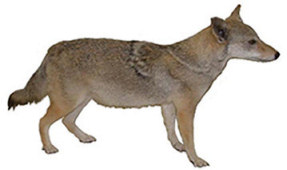 CENTENNIAL MUSEUM - CHIHUAHUAN DESERT
GARDENS—THE UNIVERSITY OF TEXAS AT EL PASO
CENTENNIAL MUSEUM - CHIHUAHUAN DESERT
GARDENS—THE UNIVERSITY OF TEXAS AT EL PASO
COYOTE
Prairie wolf, Little wolf
Centennial Museum Collection
Scientific name: Canis latrans
(Barking Dog)
Systematics
Class: Mammalia
Order: Carnivora
Family: Canidae
Description: A coyote is about 2 feet tall, measures 40-60 inches, including tail, and weighs 15 to 45 pounds, making it about the size of a Collie dog (Canis familiaris). It has a pointed muzzle and large upright tri-angular ears that are moved to facilitate acute hearing or to show position and mood. Its round, bushy tail signals aggression when it is held horizontally. The tail is often black tipped, while the rest of body is mottled brownish-gray with a creamy-white under belly and throat. Black-tipped guard hairs make a dorsal stripe and dark cross on the shoulder. Its black nose detects carrion and prey as well as the territorial markers left by other coyotes. While there are five digits on the forefeet, including the dewclaw, there are only four on the hindfeet.
Only the coyote's toes touch the ground when it is walking, thus making it a digitigrade mammal.
Distribution: In the United States, the coyote originally was limited primarily to the Great Plains and westward. Now it can be found in every state except Hawaii and ranges from eastern Alaska south to Panama. It is very adept and clever at changing its diet, social dynamics, and breeding habits to survive in diverse environments, including urban habitats.
Food: Coyotes eat small mammals, insects, carrion, and reptiles, but will also take birds, pilfer garbage, and eat vege-table matter and fruit. Although primarily nocturnal, they hunt during both day and night hours by tracking, stalking, running swiftly, and catching their prey. Co-operative hunting can take large prey.
Breeding/Family Life: Mating takes place usually between January and April, and a pair is monogamous at least for the season. The gestation time is around 65 days and there are three to nine puppies in a litter. After about 2 weeks, the blind babies open their eyes. They suckle for the first 5 to 7 weeks, although they start eating semi-solid food at about 3 weeks. The male helps with the young by requrgitating food for the pups. Between 6 and 10 weeks, the parents start taking the pups out of the den to hunt in a group. By fall they can hunt alone and by the end of the year the family disbands and the new generation is staking out its own territory.
Coyote Sounds: The Coyote's huff, bark, yelp, and howl have become associated with western night sounds. In coyote lan-guage, the huffing sounds are used to quietly call pups; the barking indicates that there is a threat; the yelping celebrates or criticizes others in the group and is often used by the young during play; the howling communicates with others in the area. Howling is heard more often in January and February when mates are being found and again in September and October when mother calls offspring.
